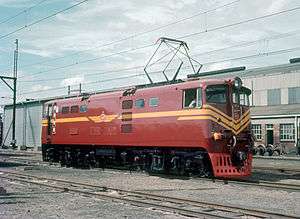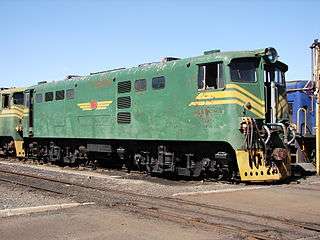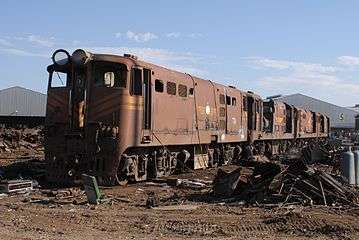South African Class 5E1, Series 2
The South African Railways Class 5E1, Series 2 of 1963 was an electric locomotive.
| South African Class 5E1, Series 2 | |||||||||||||||||||||||||||||||||||||||||||||||||||||||||||||
|---|---|---|---|---|---|---|---|---|---|---|---|---|---|---|---|---|---|---|---|---|---|---|---|---|---|---|---|---|---|---|---|---|---|---|---|---|---|---|---|---|---|---|---|---|---|---|---|---|---|---|---|---|---|---|---|---|---|---|---|---|---|
 No. E610 at Paardeneiland Depot, 11 April 1970 | |||||||||||||||||||||||||||||||||||||||||||||||||||||||||||||
| |||||||||||||||||||||||||||||||||||||||||||||||||||||||||||||
| |||||||||||||||||||||||||||||||||||||||||||||||||||||||||||||
| |||||||||||||||||||||||||||||||||||||||||||||||||||||||||||||
| |||||||||||||||||||||||||||||||||||||||||||||||||||||||||||||
In 1963 and 1964 the South African Railways placed 130 Class 5E1, Series 2 electric locomotives with a Bo-Bo wheel arrangement in mainline service. These were the first electric locomotives to be built in South Africa in quantity.[1]
Manufacturer
Series 2 of the Metropolitan-Vickers (Metrovick)-designed 3 kV DC Class 5E1 electric locomotive was built for the South African Railways (SAR) by Union Carriage and Wagon (UCW) in Nigel, Transvaal, with the electrical equipment being supplied by Associated Electrical Industries (AEI).[2][3]
UCW, at the time Australian-owned, had opened its works at Nigel in 1959 and the building of the Class 5E1, Series 2 was its first large locomotive order.[4]
It did not allocate builder's numbers to the locomotives it built for the SAR, but used the SAR unit numbers for record keeping. The Series 2 locomotives were all built in 1963 and were numbered in the range from E591 to E720.[1]
No. E591, the series leader, was officially handed over to the SAR in January 1963 as the first mainline electric locomotive constructed in South Africa.[5]
Identifying features
The locomotive had two cut-outs on the roofline on the roof access ladder side, but an unbroken roofline on the opposite side. Like the predecessor Class 5E, the Class 5E1, Series 1 and 2 had two rectangular access panels on the lower sides above the battery box, but they also had an additional rectangular panel on the lower sides above the second axle from the left.
The Series 1 and 2 locomotives could be distinguished from each other by the builder's plates on their end doors, a rectangular Metropolitan-Vickers plate on Series 1 locomotives and an oval Union Carriage and Wagon plate on Series 2. The Series 3, 4 and 5 locomotives could be visually distinguished from earlier models by their three small square access panels on the lower sides above the battery box instead of the two larger rectangular panels on the Series 1 and 2 locomotives.
Traction motor bearings
The axle-hung traction motors of all earlier SAR electric locomotives were suspended on the axles by means of plain oil-lubricated bearings consisting of bronze shells with white metal linings. After the introduction of the more powerful Class 5E1, Series 1, considerable trouble was experienced due to flaking of the white metal linings as a result of the increased intensity of the pressure on these bearings. The use of roller bearings was investigated and one traction motor of a Class 1E was converted for trial purposes. Since satisfactory results were obtained, it was decided to alter the specifications and equip the AEI 281 AZX traction motors of these 130 UCW-built Series 2 locomotives with roller-type suspension bearings.[6]
The arrangement consisted of a self-aligning spherical roller bearing at the pinion end and a parallel roller bearing at the commutator end of the traction motor. The bearings were grease-lubricated and were carried in a split cannon box to which the traction motor was attached by means of two clamps which engaged cylindrically-machined seatings on the outside of the housing. The roller-type suspension bearings required little attention other than the replenishment of the grease when the wheels were removed for tyre-turning.[6]
Orders for the subsequent Class 5E1, Series 3 and later models made provision for roller suspension bearings incorporating a lip-type cylindrical roller bearing to replace the self-aligning ball bearing at the pinion end, and alternatively for tapered roller bearings at both ends. Since the external dimensions of the bearing housings would remain the same, the traction motors would still be freely interchangeable.[6]
Service
The Class 5E1 family served on all 3 kV DC electrified mainlines country-wide for almost forty years. They worked the vacuum-braked goods and mainline passenger trains over the lines radiating south, west and north of Durban almost exclusively until the mid-1970s and Class 6E1s only became regular motive power in Natal when air-braked car trains began running between Durban and the Reef. By the early 2000s the Series 2 locomotives were all withdrawn.[7]
After withdrawal from SAR service, fifteen of the Series 2 locomotives were sold to the Middelburg, Transvaal mines of the Ingwe Coal Corporation, where three were later scrapped and the rest renumbered in the range from 5401 to 5412. The Ingwe locomotives were numbers E607, E609, E617, E630, E649, E650, E655, E661, E669, E670, E673, E675, E678, E681 and E696.[3]
Liveries
When the SAR celebrated 100 years of railways in South Africa in 1960, new colour schemes were adopted for passenger stock as well as electric and diesel-electric locomotives. Gulf Red with signal red cowcatchers was the colour initially chosen for locomotives and the yellow whiskers and stripes were carried over from the earlier green livery. As it had been on the green livery, the yellow side-stripes were initially applied to the full body-length of electric locomotives, but in the 1970s these were curtailed to just beyond the cab-sides, with the number plates on the sides still enclosed in three-stripe wings.[8]
Preservation
Currently two of the Class 5E1 Series 2 are preserved for the time being.
Illustration
The main picture shows no. E610 in the SAR Gulf Red and whiskers livery which was introduced in 1960 and in which the whole series was delivered. No. E613, displayed below in the pre-1960 SAR green and whiskers livery with incorrectly curtailed side-stripes and Bellville Depot’s trademark yellow cowcatchers, was repainted green in the early 1990s for use on Union Limited tourist trains.[3]
 No. E613 in SAR green and whiskers at Bloemfontein, Free State, 18 September 2015
No. E613 in SAR green and whiskers at Bloemfontein, Free State, 18 September 2015- No. E615 in SAR Gulf Red and whiskers, in the Bellville Yard, Cape Town, 27 June 2009
 No. E616 in SAR Gulf Red and whiskers, being cut up at Danskraal, Ladysmith, 26 April 2007
No. E616 in SAR Gulf Red and whiskers, being cut up at Danskraal, Ladysmith, 26 April 2007
References
| Wikimedia Commons has media related to South African Class 5E1, Series 2. |
- South African Railways Index and Diagrams Electric and Diesel Locomotives, 610mm and 1065mm Gauges, Ref LXD 14/1/100/20, 28 January 1975, as amended
- Paxton, Leith; Bourne, David (1985). Locomotives of the South African Railways (1st ed.). Cape Town: Struik. p. 128. ISBN 0869772112.
- Middleton, John N. (2002). Railways of Southern Africa Locomotive Guide - 2002 (as amended by Combined Amendment List 4, January 2009) (2nd, Dec 2002 ed.). Herts, England: Beyer-Garratt Publications. pp. 50, 63.
- Dulez, Jean A. (2012). Railways of Southern Africa 150 Years (Commemorating One Hundred and Fifty Years of Railways on the Sub-Continent – Complete Motive Power Classifications and Famous Trains – 1860–2011) (1st ed.). Garden View, Johannesburg, South Africa: Vidrail Productions. p. 293. ISBN 9 780620 512282.
- "UCW - Electric locomotives" (PDF). The UCW Partnership. Archived from the original (PDF) on 12 October 2007. Retrieved 30 September 2010.
- SAR&H Annual Report 1963-64, Research - Mechanical engineering. p. 73.
- Soul of A Railway, System 6, Part 3: Durban Harbour, Wests, the Bluff & Cato Creek to Congella; featuring SAR & H Harbour Craft. Captions 88-93, 98. (Accessed on 11 March 2017)
- Soul of A Railway, System 7, Western Transvaal, based in Johannesburg, Part 9. South-Eastwards as far as Volksrust (2nd part) by Les Pivnic. Caption 4. (Accessed on 11 April 2017)
- Sandstone Heritage Trust - 2017016 Locomotive status - January 2017. (Accessed on 8 March 2019)